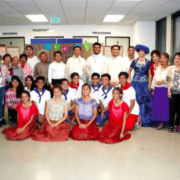THEY are the sons and daughters of dramatic journeys and fantastic tales, their stories carried like treasures as they lay down a shadow of stunning proportions, shaped both by the drama of the past and the sparkle of the moment.
They are a phenomenon all on their own — from our ancestors who came to America amid colonial romance, famine despair and political misfortune. Through them, generations of immigrants lift their heads high.
Proud of their Filipino Heritage, they left their villages, towns, cities, from which their people came, the sign posts and headlands of their Filipino past.
These are the writers, diplomats and journalists from whom the saga of the Filipino in America expresses itself, with bold and fresh aplomb.
Despite generations of separations from the Philippines, the soft talk and imaginative tale, the English language eloquence is close to their hearts and tongues.
We remember the lyrical words of a grandmother who can quote Shelly, Yeats, Byron and Wordsworth in poetic splendor, or the pipe smoke of a rapscallion grandfather that makes the sea sky of the old country—a reality in the new.
They are the children of Filipino patriots and minute men: manongs, train drivers, farmers, brick layers, carpenters, camineros.
A poignant history unfolds in their every stories, beneath the success of achievements of individual careers, a long invisible thread holds to the ancient land of family origins and tribunal lore.
In cooperation and joyful partnership with the Philippine Consulate, the Philippine Institute of Language and Culture (PILAC) on Aug. 19, showcased the unique combination of age old charm and appeal of yesterday’s Harana or love songs for the beloved. The participation of coloratura, soprano, Dame Aida Bautista Reyes, drew a rousing acceptance, if not profound appreciation among the guests of the evening.
The evening presentation themed, “Kahapon, Ngayon at Bukas,” was filled with commemorative events: the Buwan ng Wika, martyrdom of Ninoy Aquino, our National Heroes’ Day, patriotic song of “May pag-asa.” Stephanie Sahor and Eddie Gana Jr. also shared inspiring and amazing words on Sunday. The folk dances enhanced the overall theme of the celebration, like passing down a gift of heritage.
“PILAC has been at the forefront of promoting the proper usage of Filipino as second language here in California, with the ultimate commitment and dedication to have our national language, arts and culture taught and imparted to Filipino-American students in the community,” PILAC President Emily Roberts said.
“Its continuance between generations lies in our decision to choose what important values we want to pass on the to our children. Being Filipino brings responsibilities, as well as opportunities and a commitment to treasure the sources of our rights and freedoms, derived from the struggles of those who fought and died to preserve them.”
PILAC incoming President, Bernie Targa Ganon, added: “our main objective is to significantly contribute to the development of the Filipino, as a major language, have been the principle of our organization.”







